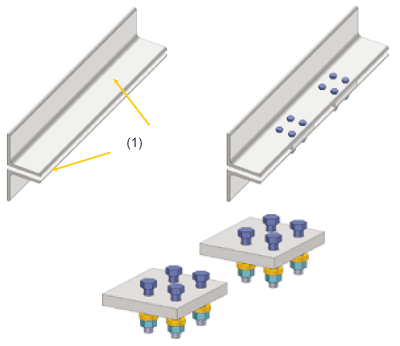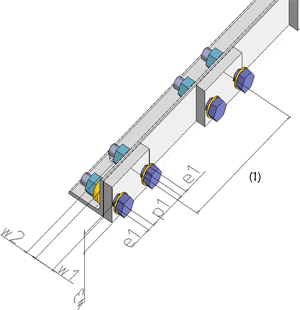
Project: HiCAD Steel Engineering
"Civil Engineering" docking window > Steel Engineering > Macros > Gusset plate
Batten plates are generated using the settings of the Batten plates and Material tabs.
Proceed as follows:

Double L beam with batten plates, (1) Main direction
![]() Please note:
Please note:
The appearance of the batten plates is defined via the Batten plate and Material tabs (for Main direction)

Bolting offsets
![]() The values that you enter on this tab will be the default
settings the next time you call the function!
The values that you enter on this tab will be the default
settings the next time you call the function!

Parameters in the batten plate, (1) Division
The offset can be calculated automatically or specified explicitly.
| Division algorithm without offsets | Division algorithm with offsets |
|---|---|
|
Example: Main direction: 1000 mm -> Length/offset = 1000/300 = 3.3 The division starts with an offset: The first plate has its bolt axis at 250, the second plate at 500 and the third and last at 750. |
Example: Main direction: 1000 mm The main direction is now divided from position 100mm to position 950mm, according to the above method: -> Length/offset = 850/300 = 2.83 The division starts with an offset: The first plate has its bolt axis at 100 + 283.3, the second plate has its at 100 + 2 * 283.3. |
The values can either be taken from the standard table or entered directly. Standard table here refers to the table defined for the beam in the standard catalogue. You can use the catalogue editor to define new catalogues and tables
If you use series beams, i.e. derive the beams from 2-D parts , you can also assign parameters w1, w2, w3 to the 2-D figures. In this case, the values assigned to the 2-D part are used for fitting batten or gusset plates. The Detect in table checkbox needs to be active in this case.

Further Connections + Construction Aids (3-D SE) • Connections + Variants (3-D SE) • Steel Engineering Functions
|
© Copyright 1994-2019, ISD Software und Systeme GmbH |